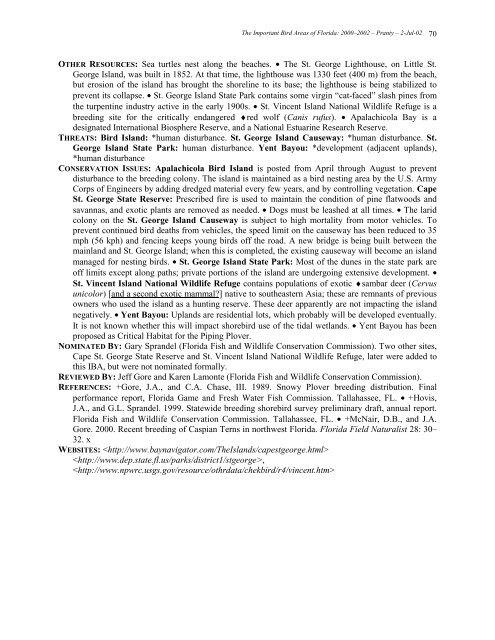The Important Bird Areas of Florida - National Audubon Society
The Important Bird Areas of Florida - National Audubon Society
The Important Bird Areas of Florida - National Audubon Society
You also want an ePaper? Increase the reach of your titles
YUMPU automatically turns print PDFs into web optimized ePapers that Google loves.
<strong>The</strong> <strong>Important</strong> <strong>Bird</strong> <strong>Areas</strong> <strong>of</strong> <strong>Florida</strong>: 2000–2002 – Pranty – 2-Jul-02 70OTHER RESOURCES: Sea turtles nest along the beaches. • <strong>The</strong> St. George Lighthouse, on Little St.George Island, was built in 1852. At that time, the lighthouse was 1330 feet (400 m) from the beach,but erosion <strong>of</strong> the island has brought the shoreline to its base; the lighthouse is being stabilized toprevent its collapse. • St. George Island State Park contains some virgin “cat-faced” slash pines fromthe turpentine industry active in the early 1900s. • St. Vincent Island <strong>National</strong> Wildlife Refuge is abreeding site for the critically endangered ♦red wolf (Canis rufus). • Apalachicola Bay is adesignated International Biosphere Reserve, and a <strong>National</strong> Estuarine Research Reserve.THREATS: <strong>Bird</strong> Island: *human disturbance. St. George Island Causeway: *human disturbance. St.George Island State Park: human disturbance. Yent Bayou: *development (adjacent uplands),*human disturbanceCONSERVATION ISSUES: Apalachicola <strong>Bird</strong> Island is posted from April through August to preventdisturbance to the breeding colony. <strong>The</strong> island is maintained as a bird nesting area by the U.S. ArmyCorps <strong>of</strong> Engineers by adding dredged material every few years, and by controlling vegetation. CapeSt. George State Reserve: Prescribed fire is used to maintain the condition <strong>of</strong> pine flatwoods andsavannas, and exotic plants are removed as needed. • Dogs must be leashed at all times. • <strong>The</strong> laridcolony on the St. George Island Causeway is subject to high mortality from motor vehicles. Toprevent continued bird deaths from vehicles, the speed limit on the causeway has been reduced to 35mph (56 kph) and fencing keeps young birds <strong>of</strong>f the road. A new bridge is being built between themainland and St. George Island; when this is completed, the existing causeway will become an islandmanaged for nesting birds. • St. George Island State Park: Most <strong>of</strong> the dunes in the state park are<strong>of</strong>f limits except along paths; private portions <strong>of</strong> the island are undergoing extensive development. •St. Vincent Island <strong>National</strong> Wildlife Refuge contains populations <strong>of</strong> exotic ♦sambar deer (Cervusunicolor) [and a second exotic mammal?] native to southeastern Asia; these are remnants <strong>of</strong> previousowners who used the island as a hunting reserve. <strong>The</strong>se deer apparently are not impacting the islandnegatively. • Yent Bayou: Uplands are residential lots, which probably will be developed eventually.It is not known whether this will impact shorebird use <strong>of</strong> the tidal wetlands. • Yent Bayou has beenproposed as Critical Habitat for the Piping Plover.NOMINATED BY: Gary Sprandel (<strong>Florida</strong> Fish and Wildlife Conservation Commission). Two other sites,Cape St. George State Reserve and St. Vincent Island <strong>National</strong> Wildlife Refuge, later were added tothis IBA, but were not nominated formally.REVIEWED BY: Jeff Gore and Karen Lamonte (<strong>Florida</strong> Fish and Wildlife Conservation Commission).REFERENCES: +Gore, J.A., and C.A. Chase, III. 1989. Snowy Plover breeding distribution. Finalperformance report, <strong>Florida</strong> Game and Fresh Water Fish Commission. Tallahassee, FL. • +Hovis,J.A., and G.L. Sprandel. 1999. Statewide breeding shorebird survey preliminary draft, annual report.<strong>Florida</strong> Fish and Wildlife Conservation Commission. Tallahassee, FL. • +McNair, D.B., and J.A.Gore. 2000. Recent breeding <strong>of</strong> Caspian Terns in northwest <strong>Florida</strong>. <strong>Florida</strong> Field Naturalist 28: 30–32. xWEBSITES: ,
















